1999 FORD F150 check engine light
[x] Cancel search: check engine lightPage 176 of 232
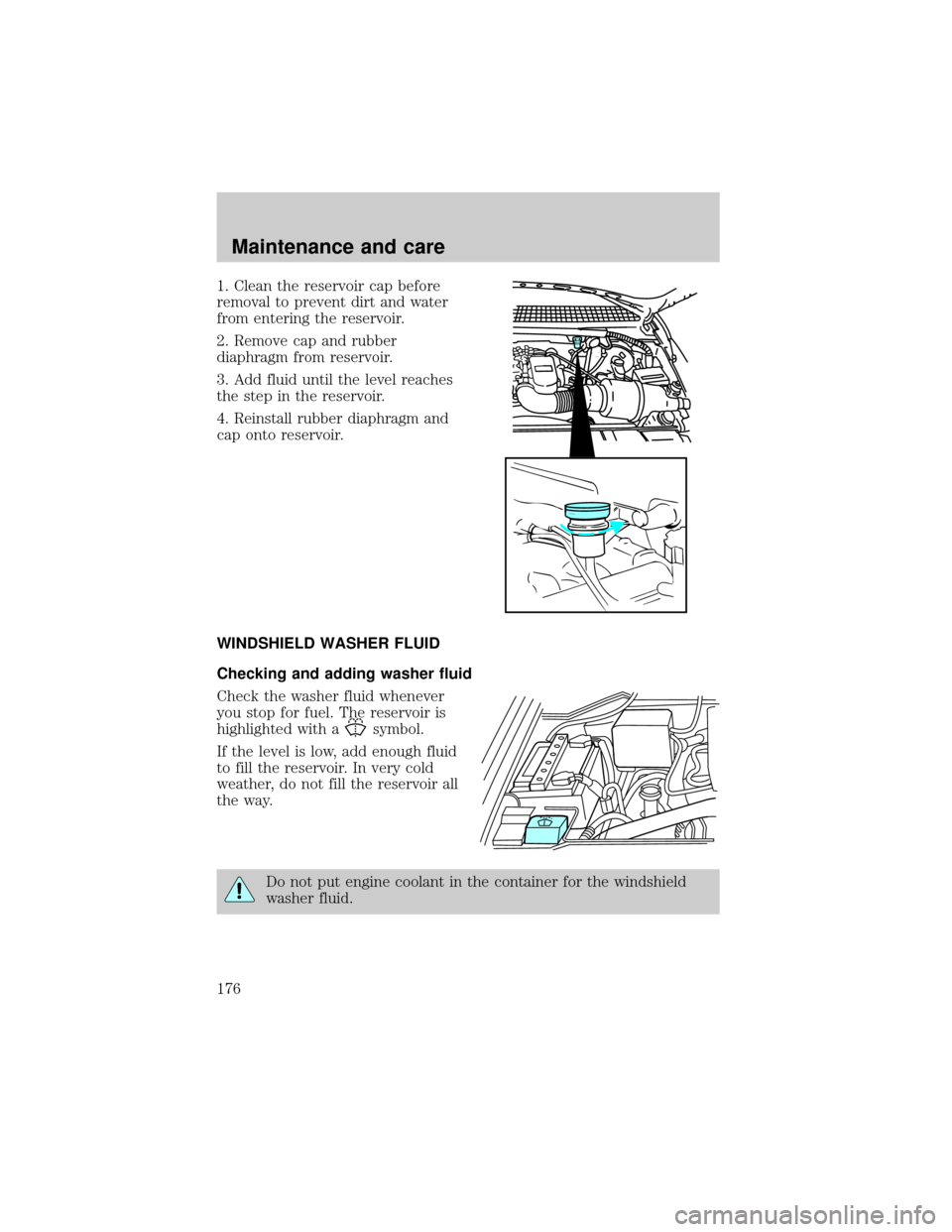
1. Clean the reservoir cap before
removal to prevent dirt and water
from entering the reservoir.
2. Remove cap and rubber
diaphragm from reservoir.
3. Add fluid until the level reaches
the step in the reservoir.
4. Reinstall rubber diaphragm and
cap onto reservoir.
WINDSHIELD WASHER FLUID
Checking and adding washer fluid
Check the washer fluid whenever
you stop for fuel. The reservoir is
highlighted with a
symbol.
If the level is low, add enough fluid
to fill the reservoir. In very cold
weather, do not fill the reservoir all
the way.
Do not put engine coolant in the container for the windshield
washer fluid.
Maintenance and care
176
Page 179 of 232
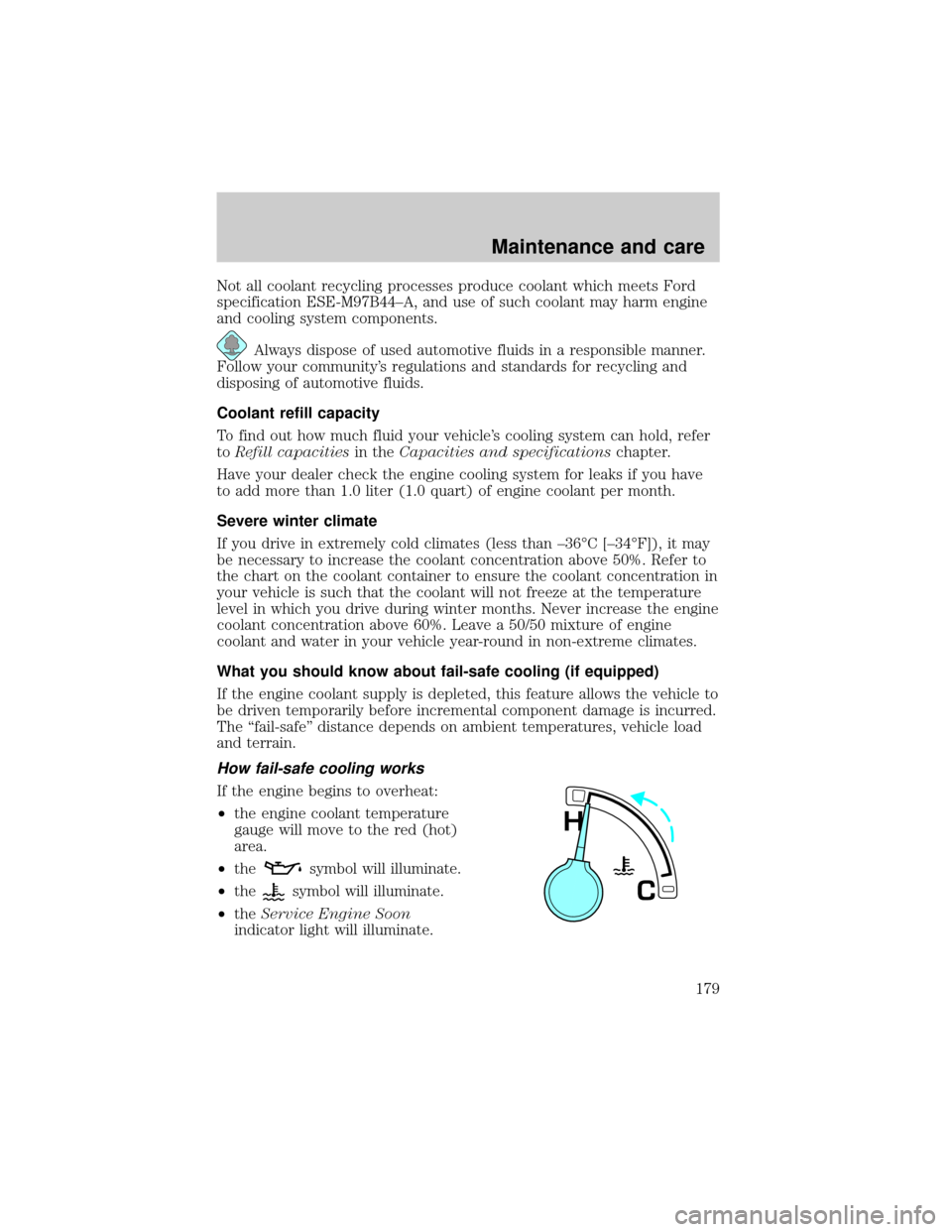
Not all coolant recycling processes produce coolant which meets Ford
specification ESE-M97B44±A, and use of such coolant may harm engine
and cooling system components.
Always dispose of used automotive fluids in a responsible manner.
Follow your community's regulations and standards for recycling and
disposing of automotive fluids.
Coolant refill capacity
To find out how much fluid your vehicle's cooling system can hold, refer
toRefill capacitiesin theCapacities and specificationschapter.
Have your dealer check the engine cooling system for leaks if you have
to add more than 1.0 liter (1.0 quart) of engine coolant per month.
Severe winter climate
If you drive in extremely cold climates (less than ±36ÉC [±34ÉF]), it may
be necessary to increase the coolant concentration above 50%. Refer to
the chart on the coolant container to ensure the coolant concentration in
your vehicle is such that the coolant will not freeze at the temperature
level in which you drive during winter months. Never increase the engine
coolant concentration above 60%. Leave a 50/50 mixture of engine
coolant and water in your vehicle year-round in non-extreme climates.
What you should know about fail-safe cooling (if equipped)
If the engine coolant supply is depleted, this feature allows the vehicle to
be driven temporarily before incremental component damage is incurred.
The ªfail-safeº distance depends on ambient temperatures, vehicle load
and terrain.
How fail-safe cooling works
If the engine begins to overheat:
²the engine coolant temperature
gauge will move to the red (hot)
area.
²the
symbol will illuminate.
²the
symbol will illuminate.
²theService Engine Soon
indicator light will illuminate.C
H
Maintenance and care
179
Page 187 of 232
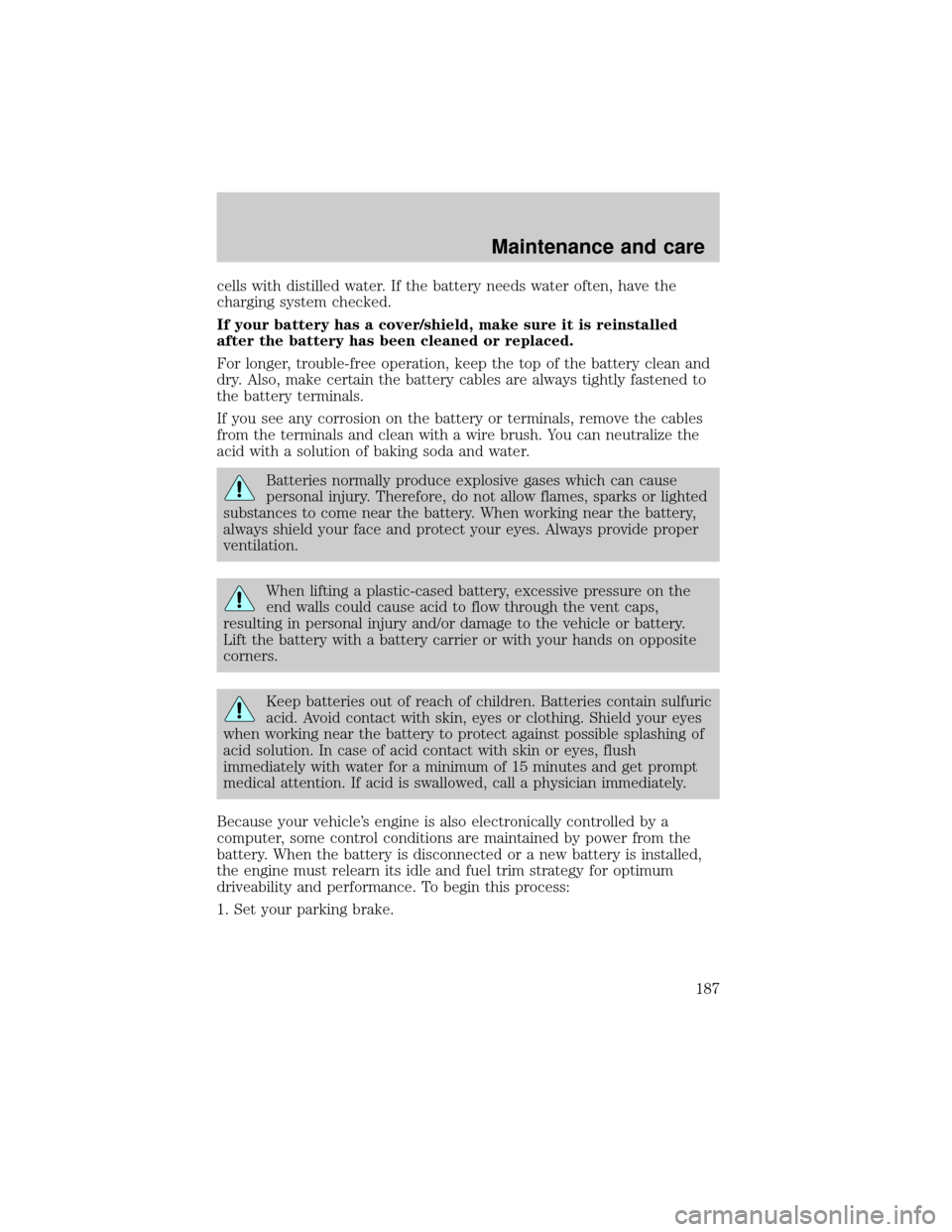
cells with distilled water. If the battery needs water often, have the
charging system checked.
If your battery has a cover/shield, make sure it is reinstalled
after the battery has been cleaned or replaced.
For longer, trouble-free operation, keep the top of the battery clean and
dry. Also, make certain the battery cables are always tightly fastened to
the battery terminals.
If you see any corrosion on the battery or terminals, remove the cables
from the terminals and clean with a wire brush. You can neutralize the
acid with a solution of baking soda and water.
Batteries normally produce explosive gases which can cause
personal injury. Therefore, do not allow flames, sparks or lighted
substances to come near the battery. When working near the battery,
always shield your face and protect your eyes. Always provide proper
ventilation.
When lifting a plastic-cased battery, excessive pressure on the
end walls could cause acid to flow through the vent caps,
resulting in personal injury and/or damage to the vehicle or battery.
Lift the battery with a battery carrier or with your hands on opposite
corners.
Keep batteries out of reach of children. Batteries contain sulfuric
acid. Avoid contact with skin, eyes or clothing. Shield your eyes
when working near the battery to protect against possible splashing of
acid solution. In case of acid contact with skin or eyes, flush
immediately with water for a minimum of 15 minutes and get prompt
medical attention. If acid is swallowed, call a physician immediately.
Because your vehicle's engine is also electronically controlled by a
computer, some control conditions are maintained by power from the
battery. When the battery is disconnected or a new battery is installed,
the engine must relearn its idle and fuel trim strategy for optimum
driveability and performance. To begin this process:
1. Set your parking brake.
Maintenance and care
187
Page 198 of 232
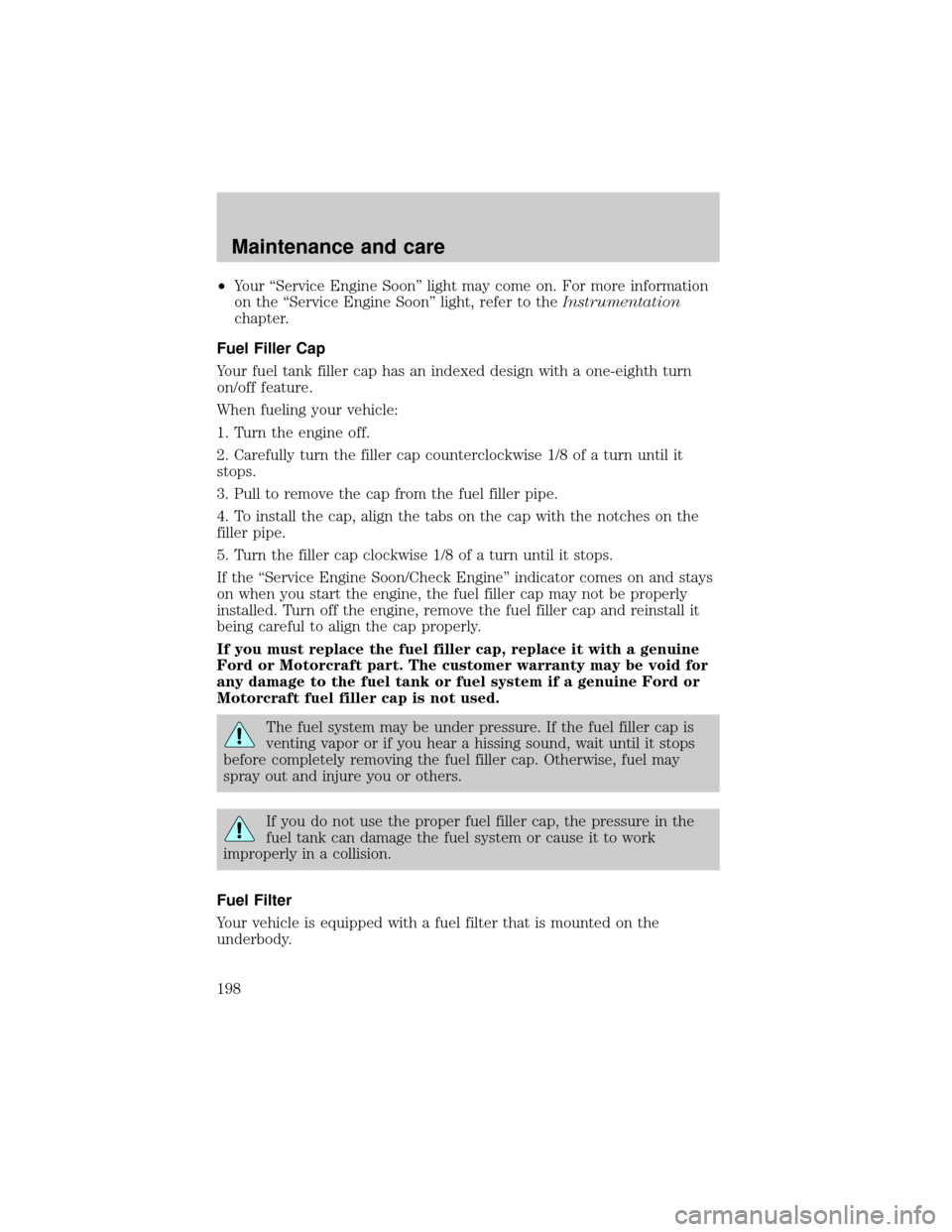
²Your ªService Engine Soonº light may come on. For more information
on the ªService Engine Soonº light, refer to theInstrumentation
chapter.
Fuel Filler Cap
Your fuel tank filler cap has an indexed design with a one-eighth turn
on/off feature.
When fueling your vehicle:
1. Turn the engine off.
2. Carefully turn the filler cap counterclockwise 1/8 of a turn until it
stops.
3. Pull to remove the cap from the fuel filler pipe.
4. To install the cap, align the tabs on the cap with the notches on the
filler pipe.
5. Turn the filler cap clockwise 1/8 of a turn until it stops.
If the ªService Engine Soon/Check Engineº indicator comes on and stays
on when you start the engine, the fuel filler cap may not be properly
installed. Turn off the engine, remove the fuel filler cap and reinstall it
being careful to align the cap properly.
If you must replace the fuel filler cap, replace it with a genuine
Ford or Motorcraft part. The customer warranty may be void for
any damage to the fuel tank or fuel system if a genuine Ford or
Motorcraft fuel filler cap is not used.
The fuel system may be under pressure. If the fuel filler cap is
venting vapor or if you hear a hissing sound, wait until it stops
before completely removing the fuel filler cap. Otherwise, fuel may
spray out and injure you or others.
If you do not use the proper fuel filler cap, the pressure in the
fuel tank can damage the fuel system or cause it to work
improperly in a collision.
Fuel Filter
Your vehicle is equipped with a fuel filter that is mounted on the
underbody.
Maintenance and care
198
Page 201 of 232
![FORD F150 1999 10.G Owners Manual ²Drive at reasonable speeds (traveling at 105 km /h [65 mph] uses 15%
more fuel than traveling at 88 km/h [55 mph]).
²Revving the engine before turning it off may reduce fuel economy.
²Use of the a FORD F150 1999 10.G Owners Manual ²Drive at reasonable speeds (traveling at 105 km /h [65 mph] uses 15%
more fuel than traveling at 88 km/h [55 mph]).
²Revving the engine before turning it off may reduce fuel economy.
²Use of the a](/manual-img/11/5018/w960_5018-200.png)
²Drive at reasonable speeds (traveling at 105 km /h [65 mph] uses 15%
more fuel than traveling at 88 km/h [55 mph]).
²Revving the engine before turning it off may reduce fuel economy.
²Use of the air conditioner or defroster may reduce fuel economy.
²Use of speed control (if equipped) may improve fuel economy. Speed
control can help maintain a constant speed and reduce speed changes.
You may want to turn off the speed control in hilly terrain as
unnecessary shifting between third and fourth gears may occur and
could result in reduced fuel economy.
²Warming up a vehicle on cold mornings is not required and may
reduce fuel economy.
²Resting your foot on the brake pedal while driving may reduce fuel
economy.
²Combine errands and minimize stop-and-go driving.
Maintenance
²Keep tires properly inflated and use only recommended size.
²Operating a vehicle with the wheels out of alignment will reduce fuel
economy.
²Use recommended engine oil. Refer toLubricant Specifications.
²Perform all regularly scheduled maintenance items. Follow the
recommended maintenance schedule and owner maintenance checks
found in your vehicle Scheduled Maintenance Guide.
Conditions
²Heavily loading a vehicle or towing a trailer may reduce fuel economy
at any speed.
²Carrying unnecessary weight may reduce fuel economy (approximately
2 km/h [1 mpg] is lost for every 180 kg [400 lb] of weight carried).
²Adding certain accessories to your vehicle (for example bug
deflectors, rollover/light bars, running boards, ski/luggage racks) may
reduce fuel economy.
²To maximize the fuel economy, drive with the tonneau cover installed
(if equipped).
²Use of fuel blended with alcohol may lower fuel economy.
Maintenance and care
201
Page 203 of 232
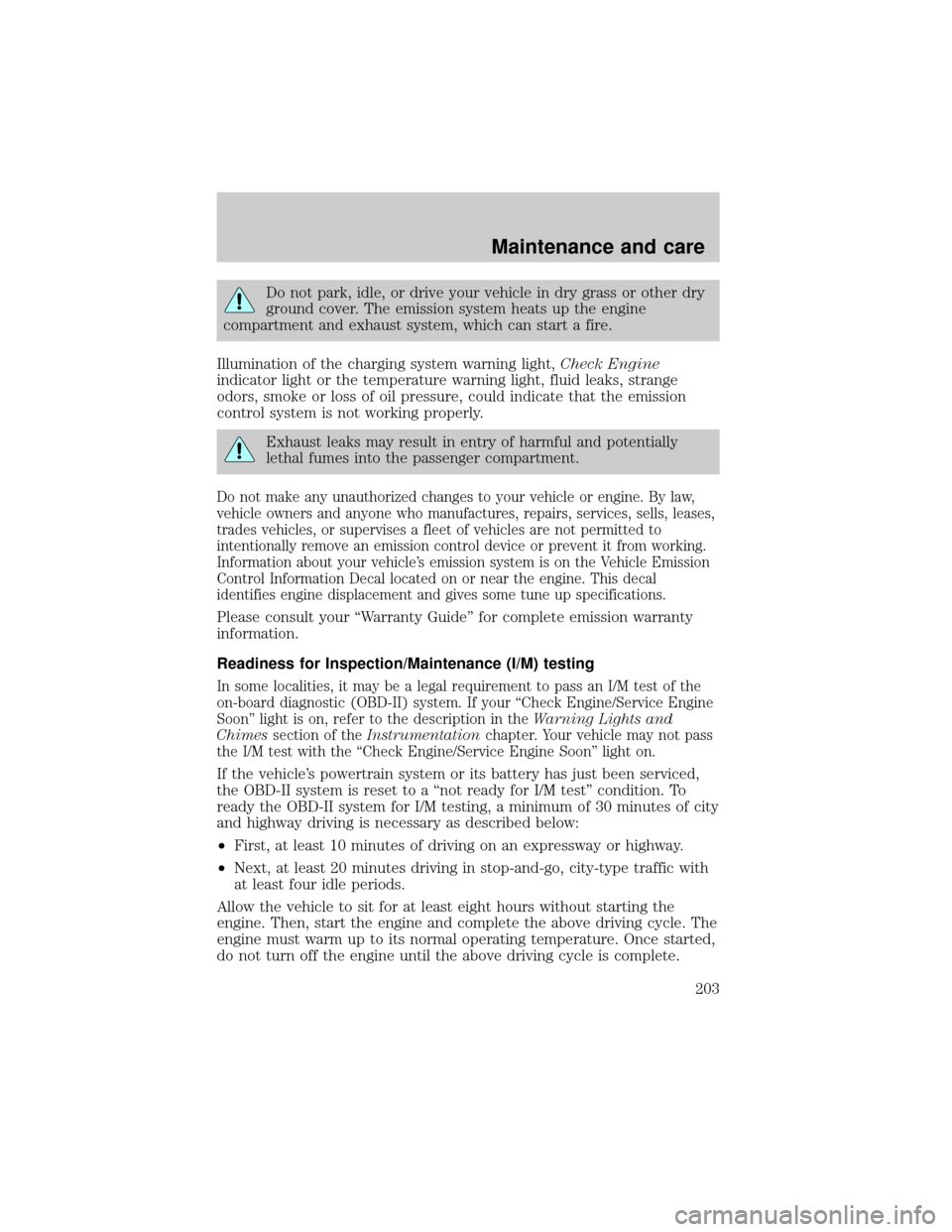
Do not park, idle, or drive your vehicle in dry grass or other dry
ground cover. The emission system heats up the engine
compartment and exhaust system, which can start a fire.
Illumination of the charging system warning light,Check Engine
indicator light or the temperature warning light, fluid leaks, strange
odors, smoke or loss of oil pressure, could indicate that the emission
control system is not working properly.
Exhaust leaks may result in entry of harmful and potentially
lethal fumes into the passenger compartment.
Do not make any unauthorized changes to your vehicle or engine. By law,
vehicle owners and anyone who manufactures, repairs, services, sells, leases,
trades vehicles, or supervises a fleet of vehicles are not permitted to
intentionally remove an emission control device or prevent it from working.
Information about your vehicle's emission system is on the Vehicle Emission
Control Information Decal located on or near the engine. This decal
identifies engine displacement and gives some tune up specifications.
Please consult your ªWarranty Guideº for complete emission warranty
information.
Readiness for Inspection/Maintenance (I/M) testing
In some localities, it may be a legal requirement to pass an I/M test of the
on-board diagnostic (OBD-II) system. If your ªCheck Engine/Service Engine
Soonº light is on, refer to the description in theWarning Lights and
Chimessection of theInstrumentationchapter. Your vehicle may not pass
the I/M test with the ªCheck Engine/Service Engine Soonº light on.
If the vehicle's powertrain system or its battery has just been serviced,
the OBD-II system is reset to a ªnot ready for I/M testº condition. To
ready the OBD-II system for I/M testing, a minimum of 30 minutes of city
and highway driving is necessary as described below:
²First, at least 10 minutes of driving on an expressway or highway.
²Next, at least 20 minutes driving in stop-and-go, city-type traffic with
at least four idle periods.
Allow the vehicle to sit for at least eight hours without starting the
engine. Then, start the engine and complete the above driving cycle. The
engine must warm up to its normal operating temperature. Once started,
do not turn off the engine until the above driving cycle is complete.
Maintenance and care
203
Page 225 of 232

Accessory delay ..........................70
Air bag supplemental restraint
system ..........................................95
and child safety seats ..............96
description ................................95
disposal ......................................98
indicator light ...........................98
passenger air bag .....................96
passenger deactivation
switch ..............61,99,100,101,102
Air cleaner filter ................188,189
Air suspension ...........................119
warning light .............................11
Anti-theft system ..............76,77,78
Armrests ......................................88
Automatic transmission
driving an automatic
overdrive ...................121,122,123
Axle
refill capacities ........................215
Battery
voltage gauge ............................14
Brakes ........................................115
anti-lock ............................115,116
anti-lock brake system
(ABS) warning light ...............116
fluid, checking and adding ....174
shift interlock ..........................120
Break-in period .............................2
CD player .....................52,54,55,56
Child safety seats
attaching with tether straps ..109
in rear seat .......................106,108
tether anchorage hardware ...109
Cleaning your vehicle ...............209
engine compartment ..............211
exterior .............................210,213
exterior lamps .........................211
interior .....................................212
plastic parts ............................211
washing ....................................209
waxing .....................................210wheels ......................................210
wiper blades ............................212
Clutch
fluid ..........................................175
operation while driving ..........123
recommended
shift speeds ......................125,126
Controls
power seat .................................86
Coolant ...............................178,179
checking and adding ..............177
refill capacities ........................179
Driveline universal joint and
slip yoke ....................................186
Driving under special
conditions ...........................132,133
sand .........................................132
snow and ice ...........................133
through water .........................132
Emission control system ..........202
Engine
coolant .....................................177
idle speed control ...................186
service points ...................170,171
starting after a collision .........149
Engine block heater .................113
Engine oil
checking and adding ..............173
dipstick ....................................172
specifications ...................172,174
Exhaust fumes ..........................113
Fail safe cooling .................179,180
Four-Wheel Drive vehicles ..10,128
description .......................130,131
driving off road .......................131
electronic shift ...................18,130
indicator light ....................10,128
lever operated shift ..128,129,130
Fuel
choosing the right fuel ...........196
comparisons with EPA fuel
economy estimates .................202
Index
225
Page 226 of 232

detergent in fuel .....................197
filling your vehicle
with fuel ...........................195,198
quality ......................................197
running out of fuel .................197
safety information relating to
automotive fuels .....................195
Fuses ...................................150,151
Gas mileage
(see Fuel economy) ...199,200,201
Gauges .........................................12
engine coolant temperature
gauge .........................................13
engine oil pressure gauge ........15
fuel gauge ..................................12
GVWR
(Gross Vehicle Weight Rating)
calculating ...............................135
Hazard flashers .........................149
Headlamps
aiming ......................................209
bulb specifications ..................208
high beam ..............................9,68
warning chime ..........................11
Heating ........................................56
heater only system ..............56,57
heating and air
conditioning system ............58,60
Hood ..........................................169
Ignition .......................................219
Inspection/maintenance
(I/M) testing ..............................203
Instrument panel ..........................6
cleaning ...................................212
Keys
key in ignition chime ...............11
positions of the ignition ...........61
removing from the ignition ....127
Lamps
autolamp system .......................17
daytime running light ...............16
fog lamps ...................................16headlamps .................................16
headlamps, flash to pass ..........68
instrument panel, dimming .....17
interior lamps ...........................69
replacing bulbs ..204,206,207,208
Lane change indicator
(see Turn signal) ........................62
Lights, warning and indicator
air bag ..........................................8
air suspension .........................119
anti-lock brakes (ABS) ..............9
anti-theft .....................................9
brake ............................................8
charging system ..........................9
door ajar ....................................11
engine oil pressure ...................10
fuel reset ...................................11
low fuel ........................................6
safety belt ...................................8
service engine soon ....................7
turn signal indicator ...................9
Lumbar support, seats ..........87,88
Manual transmission
reverse .....................................127
Mirrors
fold away ...................................72
side view mirrors (power) .......71
Motorcraft parts ........................198
Octane rating ............................197
Odometer .....................................13
Overdrive .....................................68
Parking brake ............................117
Power distribution box
(see Fuses) ...............................154
Power door locks ..............70,80,81
Power steering ..........................118
fluid,
checking and adding .......181,182
Radio ....19,20,21,22,24,25,26,27,28
29,30,31,33,34,35,36
Relays ........................................150
Remote entry system ............79,80
Index
226